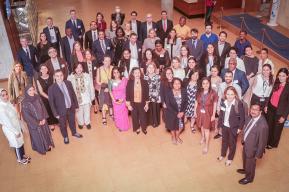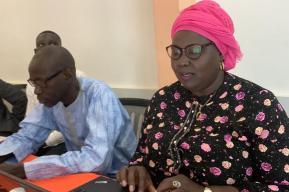From the radio right through to generative AI, when and how should we use technology in education? When does it support learning and when does it distract? Do we need to change what and how we are learning with technology to keep education relevant?
The new 2023 GEM Report, UNESCO’s flagship education publication, helps us find answers to these questions. There are many regulations on the use of technology in society, but these are not necessarily relevant in education. The Report calls for decision makers to rectify this, making sure that we are using #TechOnOurTerms, and that we prioritize learners’ needs after asking ourselves four key questions:
Benefits gained from technology can fade if it is used in excess or if there are no qualified teachers. In Peru, 1 million laptops were distributed but teachers were not trained to use them and learning did not improve.
Smartphones might be appropriate pedagogical support for some learners: for instance, they have been used in emergencies for learning continuity. However, they have no place in schools if they do not support learning. Today, fewer than a quarter of countries have banned their use in schools.
While more and more content is being put online, with many teaching and learning resources now available for both teachers and students, the content is not always context-appropriate. Nearly 90% of higher education online repositories were created either in Europe or in North America; 92% of the material in the OER Commons global library is in English.
But our focus must remain on the most marginalized as we invest. During the COVID-19 pandemic, many students relied upon technology to continue learning. But, while many managed to remain connected, one third of learners were left out, rising to over two-thirds of the poorest.
The Report describes the right to education as increasingly synonymous with the right to meaningful connectivity to the internet and yet one in four primary schools still do not even have electricity. It calls for all countries to set benchmarks for connecting all schools to the internet between now and 2030.
Technologies change faster than we can evaluate them. Most evidence comes from the United States, where the What Works Clearinghouse pointed out that less than 2% of education interventions assessed had ‘strong or moderate evidence of effectiveness’.
Evidence is also often produced by technology companies themselves, with a risk that it may be biased.
Deciding on whether to scale-up our choices means having a grasp of their long-term costs, but many ignore or are unaware of the full picture. They often see the upfront capital costs but forget the price of maintenance. This has left the EdTech market expanding while basic education needs remain unmet. The Report calculates that the maintenance costs of a full digital transformation of education with internet connectivity in schools and homes would cost over USD 1 billion per day in low- and lower-middle-income countries.
A vision of a sustainable future means protecting the rights of technology users too. There are significant risks to children’s privacy and safety online with the increased use of technology and without regulations to protect them. One analysis assessed 163 education technology products and found that nine out of ten of them could survey children, yet currently only 16% of countries protect children’s data privacy in law.
Our planet’s future is our future, and our energy consumption, and e-waste as a result of technology purchases in education must be responsible.
****
Many ask ‘how’ we should change education to absorb technology. This report asks us to question ‘why’ and ‘whether’ it will improve learning before we invest. It emphasizes the risks of getting this wrong, from invasions of children’s privacy, impact on teacher and student well-being, and safety, to distracting us from learning, disinformation, plagiarism and more. The stakes are high. And, if we don’t learn from history about past mistakes in the way that we have used technology in education so far, we will just repeat them, but on a larger scale. The ramifications – negative and positive - will be compounded as technologies expand - unless we take the time to reflect.
Because of this, the 2023 GEM Report concludes that it is essential to learn to live both with and without digital technology; to take what is needed from an abundance of information but ignore what is not necessary; to let technology support, but never supplant, the human connection on which teaching and learning are based. We learn best together.














